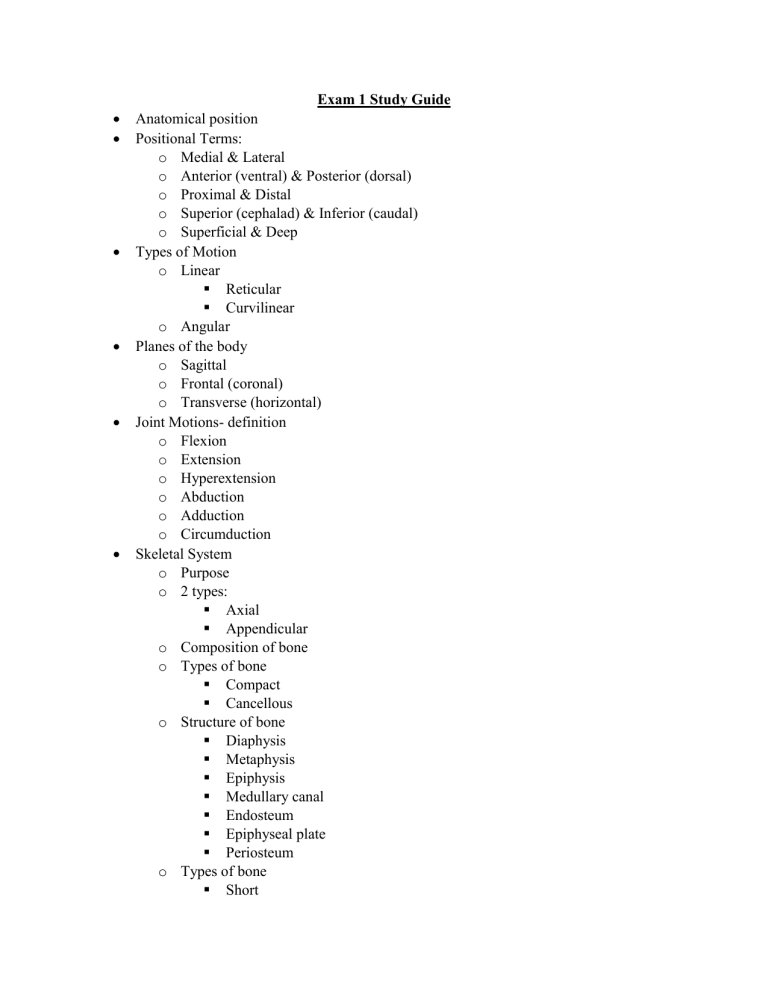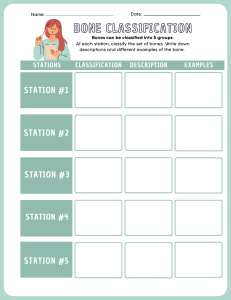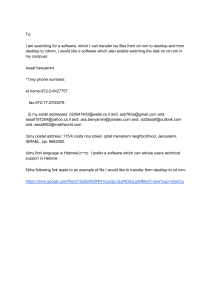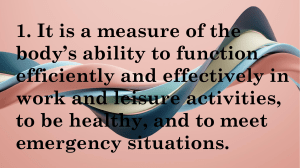
Exam 1 Study Guide Anatomical position Positional Terms: o Medial & Lateral o Anterior (ventral) & Posterior (dorsal) o Proximal & Distal o Superior (cephalad) & Inferior (caudal) o Superficial & Deep Types of Motion o Linear Reticular Curvilinear o Angular Planes of the body o Sagittal o Frontal (coronal) o Transverse (horizontal) Joint Motions- definition o Flexion o Extension o Hyperextension o Abduction o Adduction o Circumduction Skeletal System o Purpose o 2 types: Axial Appendicular o Composition of bone o Types of bone Compact Cancellous o Structure of bone Diaphysis Metaphysis Epiphysis Medullary canal Endosteum Epiphyseal plate Periosteum o Types of bone Short Flat Irregular Long Sesamoid o Articular System Stability vs. Mobility Types of joints Synarthrodial Amphiarthrodial Diarthrodial (synovial) Joint Structure Ligaments Tendons Cartilage o Hyaline o Fibrocartilage o Elastic Bursa Muscles o Origin o Insertion o Muscle characteristics: Irritability Contractibility Extensibility Elasticity o Tension o Levers: 1st class 2nd class 3rd class o Muscle contractions: Isometric Isotonic Concentric Eccentric Isokinetic o Roles of muscles Agonist Antagonist Co-contraction Stabilizer Neutralizer o Active Insufficiency o Passive Insufficiency Range of Motion and Goniometry o Disorders with decreased ROM o ROM Facts o Definitions/abbreviations: ROM PROM AROM o Why measure ROM? o End feel Hard Soft Firm o Precautions & Contraindications for ROM o Specific Procedures for measuring ROM o How to palpate for bony landmarks- which fingers do you use? o ROM is measured using a _______________. Axis Stationary bar Moveable bar o Recording measurements What degree system do we use? Normal joint motion starts at_______. ROM Limits Muscle Testing o Disorders with primary symptom of muscle weakness o Disabilities with strength loss due to mobility o Muscle testing can not be used with patients with_____________. o Precautions & Contraindications for muscle testing o ***Muscle grades and definitions*** (See FMT Grades handout) o Difference between MMT and FMT o Results of muscle weakness G/N:_______________________ F+ :_______________________ F: _______________________ F- :_______________________ P: _______________________ T or 0: _______________________ o Results for Tx Planning Coordination o Facts Cortical representation in the brain o o o o o o o o o The hand is usually the _______ part of the body to recover after a __________. Precision handling Rotation Translation away Translation towards the palm Pinch Functional position of the hand Wrist is __________ 10-30 degrees Slight _______ deviation All joints are partially ___________ Thumb is __________ and ____________ Palm is __________________ Muscles of the hand Intrinsic Extrinsic Activities that assess dexterity/coordination Treatment Planning: Developmental sequence of the hand Grip strength testing Instrument used Findings are documented in __________. Testing procedure for grip strength (see handout) Pinch strength testing Instrument used Types of pinch: Three jaw chuck Lateral (key) Tip Testing procedure for pinch strength (see handout)





